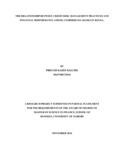| dc.description.abstract | Commercial banks in Kenya face tough competition as all the 42 banks fight for the same
customers. While most banks try to adopt flexible solutions for the purpose of gaining a
competitive advantage in the industry, there is a temptation to break rules on lending guidelines.
This is what leads to credit risk that must be managed by all commercial banks. Credit risk
management practices must be adopted by all commercial banks to ensure the continuity of
business. This is because the core business of commercial banks is lending. This study therefore
sought to establish the relationship between credit risk management practices and financial
performance among commercial banks in Kenya. The credit risk management practices that were
used in this study were: credit risk identification, credit risk evaluation, credit risk control and
the credit risk policy manual. This study’s objective was to establish the relationship between the
practices and financial performance. The population of the study was the 42 commercial banks in
Kenya and a descriptive research design was adopted. Data collection was done using
questionnaires which were given to staff working in credit departments. The questionnaires were
to provide information on the extent of use of credit risk management practices which was done
using a likert scale. Secondary data was also used to collect information on return on assets for
the commercial banks in Kenya. The multiple regression analysis was done using the SPSS data
analysis tool in order to analyze the relationship between the dependent variable (financial
performance) and the independent variables (credit risk management practices). The results of
the study indicated that there was a positive relationship between credit risk management
practices and financial performance among commercial banks in Kenya. From the findings, it
was observed that credit risk identification, credit risk evaluation, credit risk control and credit
risk policy manual have a correlation coefficient of 85.8 % with the dependent variable (financial
performance). The t-test was used in this study and the linear association of the variables showed
that they were statistically significant. The study findings revealed that all credit risk
management practices have a significant influence on financial performance of commercial
banks in Kenya. The study concluded that credit risk management has a positive influence on
financial performance. The study recommendations included improvement in risk control
systems, and constant review of credit policy in order to improve on credit risk management
practices. | en_US |



